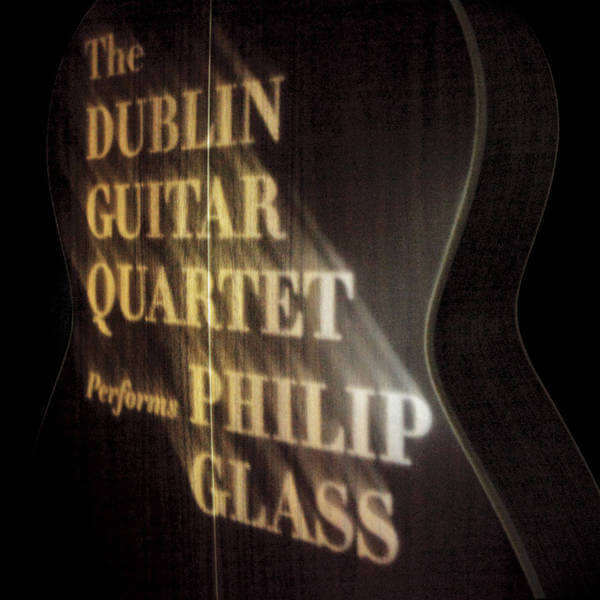Founded by students of the Dublin Conservatory of Music and Drama in 2001, the Dublin Guitar Quartet has since become a stalwart ensemble, dedicated to the interpretation and performance of contemporary classical music. Indeed, in timbre alone, the quartet’s transcription of Philip Glass’s four string quartets (excluding his first) gives new-found warmth and precision to some of the composer’s most intimate, personal pieces. Glass’s lean style lends itself well to smaller ensembles: vertical harmonic structures progress slowly by repeated ostinato patterns. Thus, the conversion from bowed instruments to four guitars, sounds native and natural. Glass’s music is riddled with arpeggiated phrases developed through additive process; the guitar eliminates sustained bow pitches, in exchange for short, defined plucked pitches, articulating all harmonic changes clearly—in this way, Glass’s music is set free from ambiguity, all notes appearing in their beautiful constructs.
Although having written his first quartet in 1966, following completion of his studies with Nadia Boulanger, Glass returned to the medium of string quartet in 1983, with his String Quartet No. 2, written as a set of pieces for a production of Samuel Beckett’s poem, Company. The first movement introduces the primary motif of a minor mode arpeggio—a theme that persists throughout all four movements. The second section is quicker, more energetic, exchanging between sudden dramatic outbursts of strumming, with quieter, expectant ostinato. In the third movement, the primary rhythmic approach of the first movement returns, leading to a violent, much anticipated climax. The final movement returns to the rapid, undulating ostinato of the second movement. Glass’s music complements Beckett’s bleak prose with a very human anxiety: “To one on his back in the dark a voice tells of a past. With occasional allusion to a present and more rarely to a future as fore example, you will end as you now are.” (from the first stanza of Samuel Beckett’s Company). The composer fills the aural space with episodes of melancholy—largely centered around A minor. The guitars lend a gentle sweetness to the music, transforming the movements into instrumental ballads of remembrance and sorrow.
The recurring theme of gloomy death and nostalgia continues with Glass’s String Quartet No. 3, adapted from the composer’s orchestral score for the film, Mishima, in 1985. The film follows various episodic moments of Japanese writer Yukio Mishima’s life, leading to his dramatic suicide. Glass employs three different instrumentations to illustrate his subject: a large orchestra accompanies short dramatizations of Mishima’s novels, and the quartet is used to illustrate flashbacks of the author’s past, culminating into a string orchestra during the final day of Mishima’s life. Indeed, it seems fitting that the composer would choose the smaller, four-person ensemble for a more personal, intimate reflection of the character’s life—one filled with a contempt for materialism, and an extreme adherence toward tradition. The quartet music is dominated by cyclical, repeating patterns, often returning to the recurring progression first introduced in the “Award Montage”. Perhaps most poignant, however, is the third movement, “1934 Grandmother & Kimitake”. The music is often tense and anxious, erupting in unexpected accented figures. Undeniably, Mishima’s relationship with his grandmother, Natsuko, was riddled with unexpected moods—the woman was known for her violent outbursts; nevertheless, the use of guitar softens the blow of Glass’s allusions, juxtaposing aural flares with warm, strummed timbres.
In Glass’s String Quartet No. 4, written in 1989, the composer pays tribute to artist Brian Buczak, who died from AIDS in 1988. It is one of Glass’s more romantic, and, at times, impressionistic works, evoking Schubertian emotion juxtaposed against Glass’s own reductive, arpeggiating chords. The first movement’s sequential chord progression moves with chromaticism in a slow, rhythmic procession. The chords evoke romantic longing, coupled with Glass’s iconic restraint. In the slower second movement, two guitars, set an octave apart, develop the melody, accompanied with the remaining guitars performing repetitive harmonies, in lower registers. Eventually, the melodic lines take on a supporting role, as the lower registered guitars emerge to perform their semitonal, drawn-out melody. The extended chromaticism, coupled with melodic octaves in the upper registers, creates an ethereal, dehumanized feeling—reminiscent of Debussy. Indeed, one has trouble having a sense of a tonal center, the music concluding upwardly, questioningly. The final movement begins with blocklike chords, leading to a luscious, descending scalar melody in the upper register. The warm tonal center is a relief from the bitonality of the first movement. Definitive resolution brings proverbial tears to the eyes—a much-needed rest (and fitting tribute) to an artist.
The medium of bowed and guitar quartet is blurred in Glass’s fifth quartet, composed in 1991. In the original composition, violin, viola, and cello alternate between bowed and plucked segments. The Dublin Guitar Quartet demonstrate this distinction with palm mute technique—the distinction both subtle and brusque. All five movements of the piece are characterized by such dichotomies: mellow, rhythmic sections are interrupted by brief, siren-like phrases in forte. Syncopated rhythms change suddenly to alternate meters, switching, concurrently between plucked and palm muted episodes.
Philip Glass’s arpeggiating, rhythmic structures are often lost in the course of his additive process. Indeed, with increasing intensity, the bowed phrases of Glass’s String Quartets envelop the listener—one has trouble differentiating the stacked voices. However, with the Dublin Guitar Quartet’s transcription, one gains a new appreciation for the composer: luscious bowings are converted to warm, concise pluckings. The result is a new-found precision in the medium, both pleasing and homely to the ear.























